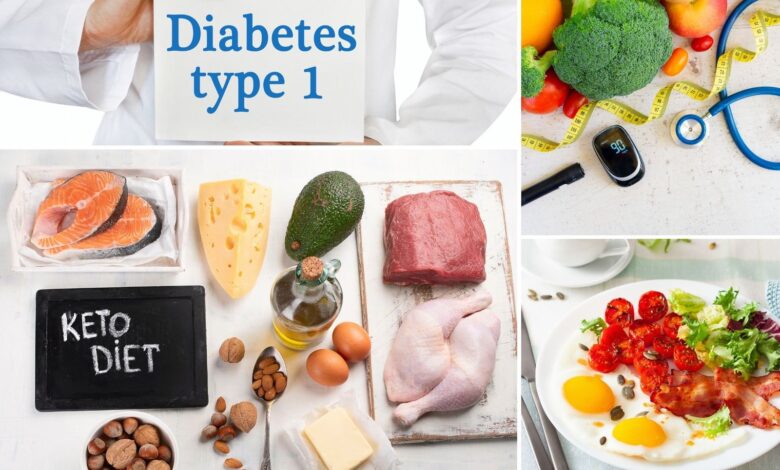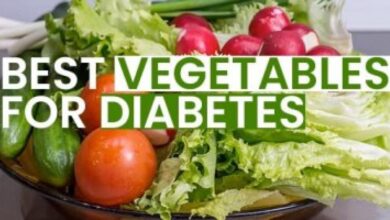Keto Diet for Type 1 Diabetes: A Step-by-Step Plan for Stable Blood Sugar Levels

Keto Diet for Type 1 Diabetes: A Step-by-Step Plan for Stable Blood Sugar Levels.
Living with Type 1 diabetes (T1D) means carefully balancing insulin, food intake, and activity levels every day. Even small changes in diet can cause big swings in blood sugar, making consistency difficult. Many people struggle with high spikes after meals or unexpected lows later in the day.
This is why the Keto Diet for Type 1 Diabetes has attracted so much attention. By focusing on low-carb, high-fat foods, the diet minimizes glucose spikes and helps people with T1D maintain more stable blood sugar. For some, it also reduces the total amount of insulin needed.
Read Also What Fruit Can Reverse Type 2 Diabetes? Exploring Nature’s Sweet Solution
But is it safe? And how can someone with T1D start the diet without putting themselves at risk? This comprehensive guide explains everything you need to know about the Keto Diet for Type 1 Diabetes—from how it works, to practical steps, potential benefits, and common pitfalls.
What is the Keto Diet for Type 1 Diabetes?
The Keto diet (short for ketogenic diet) is a low-carb, high-fat eating plan that changes how the body produces energy. Normally, we get most of our fuel from glucose (sugar) found in carbs. But when carb intake is very low, the body switches to burning fat for fuel, producing ketones in the process. This state is called ketosis.
For someone with Type 1 diabetes, the Keto Diet offers potential advantages:
- Less glucose in the bloodstream = fewer blood sugar spikes.
- Lower need for insulin = reduced risk of hypoglycemia.
- More stable energy throughout the day.
However, it’s important to understand that ketosis is different from diabetic ketoacidosis (DKA). Ketosis is a controlled metabolic state, while DKA is a dangerous condition caused by extremely high ketone levels and insufficient insulin. With medical supervision, ketosis can be safe for T1D patients.
How the Keto Diet Affects the Body
Here’s what happens when you start the Keto Diet for Type 1 Diabetes:
- Carbohydrate intake drops significantly.
Instead of 200–300g of carbs per day, many people consume only 20–50g on Keto. - Insulin demand decreases.
With fewer carbs, your body doesn’t need as much insulin to process glucose. - The liver produces ketones.
Ketones become the body’s main energy source, replacing glucose
👉 For Type 1 diabetics, this can mean smoother control, but it also requires frequent glucose checks and insulin dose adjustments.
Why Consider the Keto for Type 1 Diabetes?
1. More Stable Blood Sugar
Carbs are the biggest driver of blood sugar spikes. With the Keto Diet for Type 1 Diabetes, meals cause smaller increases in glucose, which are easier to manage with insulin.
2. Lower Insulin Requirements
Because there’s less glucose in the bloodstream, many people find they need less insulin overall. This reduces the risk of both hypoglycemia and weight gain linked to high insulin doses.
3. Improved Insulin Sensitivity
Studies suggest that low-carb diets improve the body’s ability to respond to insulin, helping make blood sugar regulation easier.
4. Better Weight Management
Some people with Type 1 diabetes struggle with weight gain from insulin therapy.
Research on the Keto Diet for Type 1 Diabetes
Although research is still developing, early findings are promising:
- HbA1c improvements: A study of T1D patients on a low-carb diet reported significant drops in HbA1c (long-term blood sugar control).
- Reduced insulin needs: Participants needed less insulin after switching to Keto.
- Better glucose stability: Many experienced fewer extreme highs and lows.
That said, most studies are small and short-term. More long-term research is needed to confirm safety and effectiveness.
Step-by-Step Plan to Start the Keto Diet for Type 1 Diabetes
Step 1: Consult Your Healthcare Provider
Always begin under medical supervision. The Keto Diet can change insulin needs quickly, so adjustments are essential.
Step 2: Learn Your Macros
A typical Keto breakdown is:
- 70–75% fat
- 20–25% protein
- 5–10% carbs (usually under 50g per day)
Step 3: Reduce Carbs Slowly
Going “cold turkey” may cause major glucose swings. Reduce carbs gradually over 2–3 weeks.
Step 4: Track Blood Sugar Closely
Test frequently, especially during the first month. Continuous glucose monitors (CGMs) are especially helpful.
Step 5: Adjust Insulin
Expect your insulin needs to drop. Work with your doctor to prevent lows.
Step 6: Stay Hydrated and Replace Electrolytes
Low-carb diets can cause fluid loss. Drink water and replenish sodium, magnesium, and potassium.
Foods to Eat on the Keto Diet for Type 1 Diabetes
Healthy Fats
- Avocados
- Olive oil
- Coconut oil
- Nuts and seeds
Proteins
- Eggs
- Chicken, turkey, beef
- Salmon, tuna, mackerel
- Tofu and tempeh
Low-Carb Vegetables
- Spinach
- Kale
- Broccoli
- Zucchini
- Cauliflower
Fiber Sources
- Chia seeds
- Flaxseeds
- Leafy greens
Foods to Avoid on the Keto Diet for Type 1 Diabetes
- Bread, rice, pasta, cereals
- Potatoes and starchy vegetables
- Sweets, cakes, cookies, and sugary drinks
- Most fruits (except small portions of berries)
Sample 1-Day Meal Plan (Keto Diet for Type 1 Diabetes)
- Breakfast: Scrambled eggs cooked in olive oil with spinach and avocado.
- Lunch: Grilled salmon with a side of zucchini noodles and olive oil dressing.
- Snack: Handful of almonds and cheese slices.
- Dinner: Chicken breast with cauliflower mash and sautéed broccoli.
- Dessert: Chia seed pudding made with unsweetened almond milk.
This type of meal plan helps keep carbs under 40–50g per day.
Risks and Challenges of the Keto Diet for Type 1 Diabetes
1. Keto Flu
Temporary symptoms like fatigue, headache, and irritability as the body adapts. Solution: Stay hydrated, consume electrolytes, and transition gradually.
2. Hypoglycemia
With reduced insulin needs, taking your usual doses can cause dangerous lows. This is why careful adjustments and frequent testing are vital.
3. Diabetic Ketoacidosis (DKA)
People with T1D are at higher risk for DKA if insulin levels drop too low. Always monitor ketones and never skip insulin, even on Keto.
4. Social & Lifestyle Barriers
Eating out, family meals, or celebrations can make Keto harder to maintain. Planning ahead helps.
Long-Term Considerations for the Keto Diet and Type 1 Diabetes
- Nutrient balance: Ensure you’re getting enough vitamins and minerals, especially fiber, magnesium, and potassium.
- Heart health: Choose healthy fats (olive oil, nuts, fatty fish) over processed meats or trans fats.
- Sustainability: Keto works well for many, but some find it hard to maintain long-term. Consider whether it fits your lifestyle.
- Regular checkups: Keep in touch with your healthcare provider to monitor kidney, liver, and heart function.
Conclusion
The keto diet offers a powerful tool for stabilizing blood sugar, reducing insulin requirements, and improving overall health. By focusing on low-carb, high-fat foods, many people achieve more consistent glucose levels and fewer complications.
However, the diet comes with risks—especially hypoglycemia and the possibility of DKA—so it should only be attempted with careful planning and professional supervision.
When done safely, the Keto Diet can help people with T1D feel more in control of their condition and enjoy better health outcomes.
Read Also What Are the Best Keto Meal for Beginners?
FAQs about the Keto for Type 1 Diabetes
1. Can the Keto Diet for Type 1 Diabetes cure diabetes?
No. It cannot cure T1D but can help manage blood sugar effectively.
2. How does Keto affect insulin needs?
Most people find they need less insulin because they eat fewer carbs.
3. Is the Keto Diet for Type 1 Diabetes safe long-term?
Yes, but it requires medical guidance, nutrient monitoring, and regular health checks.
4. What are the warning signs of low blood sugar on Keto?
Sweating, shakiness, confusion, dizziness, and blurred vision.
5. Can I do Keto if I have both Type 1 Diabetes and heart disease?
Yes, but choose heart-healthy fats and consult your doctor for personalized advice.
6. Is there a difference between ketosis and DKA?
Yes. Nutritional ketosis is safe when monitored. DKA is a dangerous condition that occurs when insulin is too low and ketones rise uncontrollably.
7. Do children with Type 1 Diabetes benefit from Keto?
Some studies suggest benefits, but it must be closely supervised by pediatric specialists.
8. What tools can help manage Type 1 Diabetes?
Continuous glucose monitors (CGMs), food tracking apps, and ketone testing kits are highly recommended.





One Comment